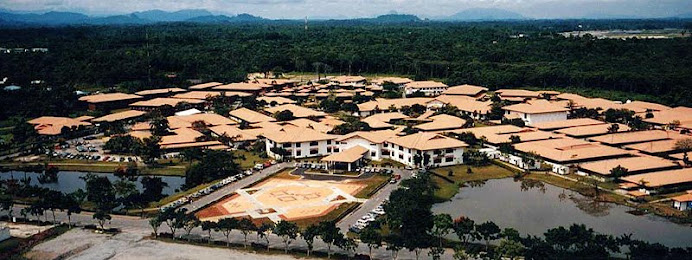We got to Sibu by way of an overnight eight-hour bus ride. For comparison, my familiar drive from Bellevue to Spokane is almost exactly the same distance as Kuching to Sibu, but it can be done twice as fast. Though they are two of the state's largest cities, there is nothing like a major freeway connecting Kuching to Sibu or any of Sarawak's other cities. Rather than I-90 through the Palouse, a constantly bumpy two-lane highway with frequent pull-offs to Malay kampungs (villages) brought us eastward through the jungle. The inside of the bus was actually really cold, but one way cost only $10, about a quarter of what Greyhound has gotten from me on multiple occasions.
-
 Sibu is smaller than Kuching, Sarawak's capital, but much larger than Kota Samarahan, the town where UNIMAS is. Its population is majority Chinese (specifically Foochow) making it, they say, one of the best places in all of Malaysia to be for Chinese New Year. Short of China, it was an ideal place to experience my first CNY celebration.
Sibu is smaller than Kuching, Sarawak's capital, but much larger than Kota Samarahan, the town where UNIMAS is. Its population is majority Chinese (specifically Foochow) making it, they say, one of the best places in all of Malaysia to be for Chinese New Year. Short of China, it was an ideal place to experience my first CNY celebration.Our bus arrived in Sibu around 7AM. The sleepless nocturnal journey put me in a mood for nothing but hitting the hay. After napping we walked around Sibu's commercial district, stopping first for a late breakfast at a locally famous rice soup restaurant. I browsed some shops and stopped just short of buying a couple t-shirts, one featuring Mario's face and the other with a cool design around the Malay word hujan (rain).
 We also saw the most prominent of Sibu's several swan statues, which are located in public spaces around the city to remind residents of the mayor's declared mission for Sibu to transform from an ugly duckling into a beautiful swan. (Kuching, by the way, similarly has statues of cats all over the place, but that's because kuching is Malay for 'cat', not because of any mission to become catlike.) Then we walked through Sarawak's biggest marketplace. I tried to rapidly take in the new sights and smells. We visited a stall operated by the parents of Julie, another UNIMAS grad we know from church, who was actually there at the time to help out during the CNY rush.
We also saw the most prominent of Sibu's several swan statues, which are located in public spaces around the city to remind residents of the mayor's declared mission for Sibu to transform from an ugly duckling into a beautiful swan. (Kuching, by the way, similarly has statues of cats all over the place, but that's because kuching is Malay for 'cat', not because of any mission to become catlike.) Then we walked through Sarawak's biggest marketplace. I tried to rapidly take in the new sights and smells. We visited a stall operated by the parents of Julie, another UNIMAS grad we know from church, who was actually there at the time to help out during the CNY rush.

 When we'd finished shopping we walked back to Valerie's parents' house, whose location close to the center of Sibu also made it ground zero for the thrilling cacophony of fireworks the next night.
When we'd finished shopping we walked back to Valerie's parents' house, whose location close to the center of Sibu also made it ground zero for the thrilling cacophony of fireworks the next night. 


Below is the portrait of Valerie's grandpa that hangs as a memorial in their family room. In search of greater opportunity he emigrated from China but failed in his first attempts at starting businesses in Sibu. Eventually he became successful making and selling bottles of traditional Chinese oil. It's an herbal concoction used on the skin to aid in the healing of cuts. Today, Valerie's dad and three brothers run the factory where this same product is mass produced and then shipped elsewhere in Malaysia as well as to Indonesia, the Philippines, and – where else – China. Later on, all of us spent an hour helping to clean the office area of this factory and then were rewarded with a tour of the rooms where the oil is made, bottled, labeled, and packaged.

 Apparently the man wore a moustache in his earlier years.
Apparently the man wore a moustache in his earlier years.

 Apparently the man wore a moustache in his earlier years.
Apparently the man wore a moustache in his earlier years.For dinner, a dozen of us ate at Sibu's most popular spot for 'pork leg'. It's just as it sounds – the cooked leg of a pig on a plate. The restaurant also serves seafood, and one of their many water tanks had large fish growing inside of plastic Coke bottles. I had some stupid theory about deliberately constraining the movement of the fish so they'd get fatter, but one of the locals said the fish are in there to give wide-eyed foreigners like me something to look at. At one point during the meal Valerie's little nephew Isaac gave his best dog impression.


 On returning home for the night, I got my first taste of flooded Sibu streets, which residents here are accustomed to withstanding every year around this time.
On returning home for the night, I got my first taste of flooded Sibu streets, which residents here are accustomed to withstanding every year around this time.


 On returning home for the night, I got my first taste of flooded Sibu streets, which residents here are accustomed to withstanding every year around this time.
On returning home for the night, I got my first taste of flooded Sibu streets, which residents here are accustomed to withstanding every year around this time. 


